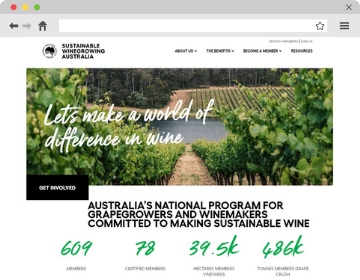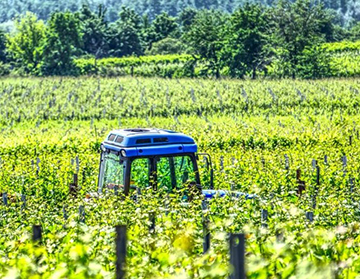23 June 2021

The 2021/22 edition of Agrochemicals registered for use in Australian viticulture (the ‘Dog book’) is now available. The updated ‘Dog book’ can be viewed via the online pdf. Distribution of hard copies will begin in July and a copy will also be included with the July issue of Australian & New Zealand Grapegrower & Winemaker.
To receive a hard copy of the ‘Dog book’ in the mail, please provide your contact details to the AWRI at http://www.awri.com.au/dog-book or scan this QR Code:
This agrochemical update summarises the major changes in the 2021/22 ‘Dog book’ compared with the previous version.
New active constituents
The Australian Pesticides and Veterinary Medicines Authority (APVMA) has recently approved the use of the following active constituents in wine-grape production:
EUGENOL, GERANIOL, THYMOL
APVMA 87197: ‘Novellus’ is a Sipcam product registered for control of botrytis bunch rot in grapevines. It is an activity group 46 fungicide.
Recommended restriction on use (withholding period) for grapes destined for export wine: Use no later than E-L 25, 80% caps off.
FLUOPYRAM + TEBUCONAZOLE
APVMA 87841: ‘Luna Experience’ is a Bayer Australia product, registered for control of botrytis bunch rot and powdery mildew in grapevines. It contains activity groups 3 + 7.
Recommended restriction on use (withholding period) for grapes destined for export wine: Use no later than E-L 17, 12 leaves separated; inflorescence well developed, single flowers separated.
TEBUFENOZIDE
APVMA 88780: ‘Ecdypro 700 WP’ is an Imtrade Australia product, registered for control of light brown apple moth in grapevines. It is an activity group 18 insecticide.
Recommended restriction on use (withholding period) for grapes destined for export wine: Use no later than E-L 25, 80% caps off.
New active constituent combinations
PYDIFLUMETOFEN + FLUDIOXONIL
APVMA 88887: ‘Miravis Prime’ is a Syngenta Australia product registered for control of botrytis bunch rot in grapevines. Application for botrytis bunch rot will also control powdery mildew. It contains activity groups 7 + 12.
Recommended restriction on use (withholding period) for grapes destined for export wine: Not recommended for use on grapes destined for export wine.
METALDEHYDE + FIPRONIL
APVMA 87832: ‘Transcend’ is an Imtrade Australia product registered for control of European earwigs, Portuguese millipedes, slaters, snails and slugs in grapevines. It is a group 2B insecticide bait.
Recommended restriction on use (withholding period) for grapes destined for export wine: Contact your winery or grape purchaser prior to the use of a group 2B insecticide.
New targets
SPINOSAD
APVMA 88118: ‘Entrust Organic’ is a Corteva Australia product registered for control of grapevine moth and light brown apple moth in grapevines. It is a group 5 insecticide.
Recommended restriction on use (withholding period) for grapes destined for export wine: Use no later than E-L 31, berries pea-size (not > 7 mm diameter).
PETROLEUM OIL
APVMA 59091: ‘Biocover’ is an AgNova product registered for control of powdery mildew on grapes.
Recommended restriction on use (withholding period) for grapes destined for export wine: Use no later than E-L 31, berries pea-size (not > 7 mm diameter).
Changes to withholding period (WHP) recommendations for export wine
MANCOZEB
The restriction on use for products containing mancozeb is now ‘Use no later than E-L 25, 80% caps off.’ This also applies to products that are co-formulated with mancozeb or products that are required to be mixed with mancozeb such as dimethomorph.
Correction – Page 7
Copper sulfate tribasic + mancozeb is incorrectly listed under the E-L 31, berries pea size (not > 7 mm diameter) restriction. This should be listed on page 6, with the restriction ‘Use no later than E-L 25, 80% caps off’.
Limits applied to number of sprays for export wine
GROUP M3: MANCOZEB, METIRAM, PROPINEB, THIRAM, ZINEB and ZIRAM
Apply no more than three sprays per season.
Note that the limit of three sprays per season includes when Group M3 fungicides are co-formulated with other active constituents such as metalaxyl (-M).
CHLOROTHALONIL
Apply no more than three sprays per season.
CYPRODINIL
Apply no more than one spray per season.
FENPYRAZAMINE
Apply no more than one spray per season.
Chemical resistance management strategies
CropLife Australia resistance management strategies are under review and minor changes are expected for the coming season. The resistance information specific to botrytis bunch rot, downy mildew and powdery mildew provided on pages 15 to 18 in the online pdf linked in this eBulletin has last season's strategies. These will be updated in July. For information about CropLife Australia resistance management strategies visit http://www.croplife.org.au. CropLife can be contacted on 02 6273 2733 or info@croplife.org.au.
Table of registered products
Products/active constituents that are underlined in the tables of registered products (pages 20 – 26) are those that are restricted for use by some wineries/grape buyers. It is recommended that prior to the use of any underlined product, growers should contact their winery or grape purchaser.
For more information or to request a copy of the new ‘Dog book’, please contact Marcel Essling on 08 8313 6600 or email helpdesk@awri.com.au.
This information is provided to inform the Australian grape and wine sector and should not be interpreted as an endorsement of any product.




